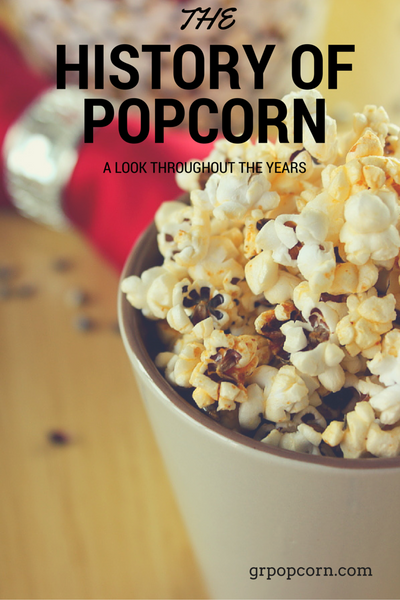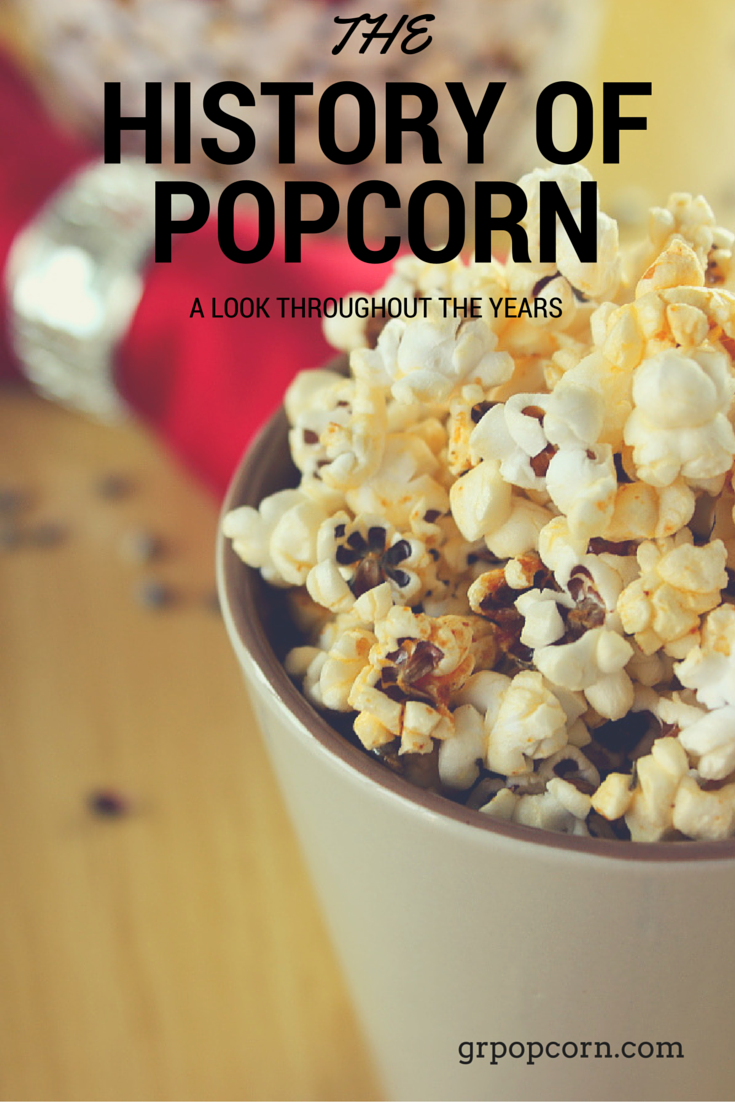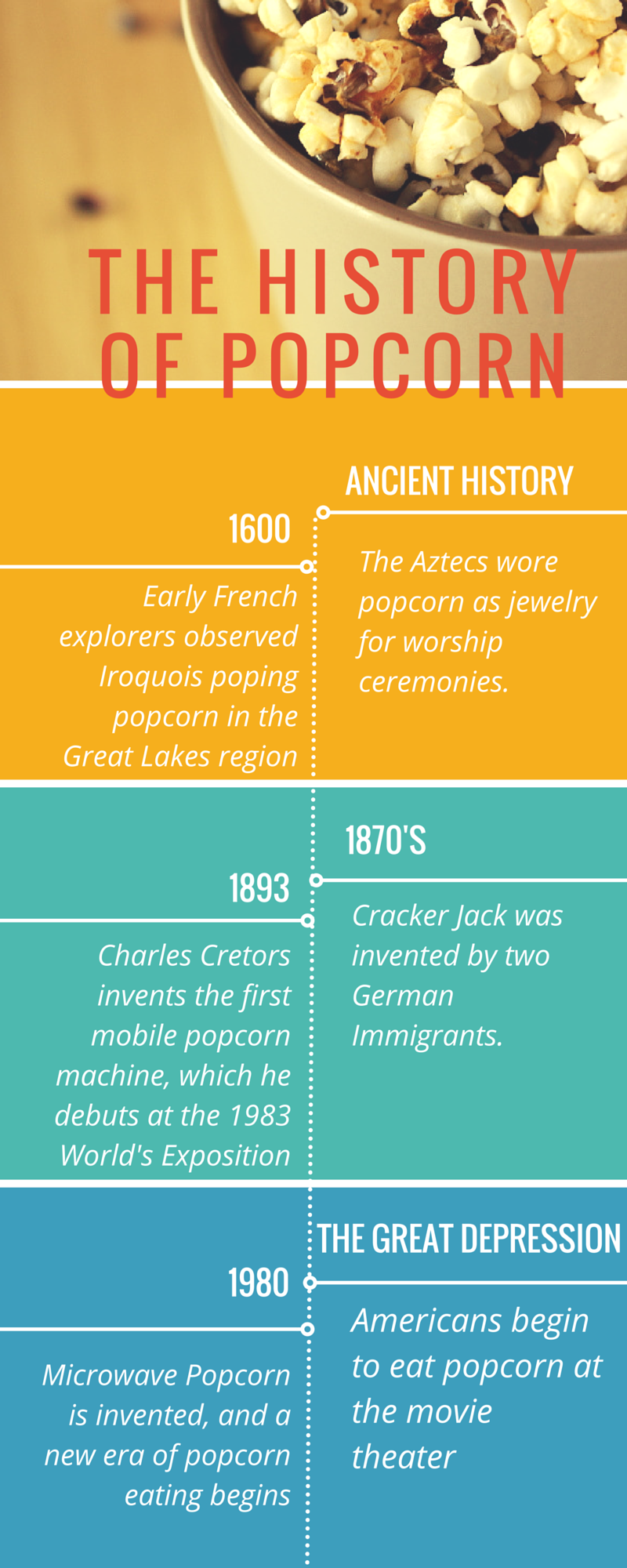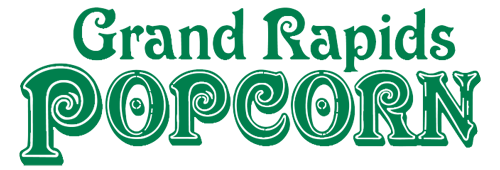
The History of Popcorn
A Look throughout the Years
 Although a simple grain, popcorn’s place in America’s culture is fairly recent. In fact, if it weren’t for the Great Depression, popcorn might not have become as large of a phenomenon as it is today. Let’s take a closer look at popcorn’s fascinating history.
Although a simple grain, popcorn’s place in America’s culture is fairly recent. In fact, if it weren’t for the Great Depression, popcorn might not have become as large of a phenomenon as it is today. Let’s take a closer look at popcorn’s fascinating history.
Ancient History
Popcorn is a form of maize, not the sweet corn-on-the-cob that most people think of. It got its name from the sound it makes when it pops. No surprise there. The oldest ear of popcorn is about 5,600 years old, and was found in a cave in central New Mexico between 1948 and 1950. Popcorn has been found in burial sites across South America. 1,000 year old Popcorn found in Peru has been preserved so well that it still pops. Popcorn was integral to South American culture, especially the Aztecs. They used popcorn in worship ceremonials, wearing it as headdresses, necklaces, and ornaments. Early French explorers observed Iroquois popping popcorn in the early 1600s in the Great Lakes region, and it became a pre-cursor to the ordinary breakfast cereals that line the grocery store shelves today. Colonial families ate it in a bowl with milk and sugar, just like the corn flakes or rice crisps we eat today. Colonists also popped popcorn with crude poppers made of cylindrical thin sheets of iron, which resembled an animal cage.
19th Century
Because of popcorn’s low cost and fun shape, it has been used as holiday decor since the 1800’s. The word “popcorn” first appeared in Bartlett’s Dictionary of Americanisms in 1838. The invention of the wire corn popper helped bring popcorn to households because it was the most convenient popper to date. Popcorn was first produced commercially across the United States in the 1840’s. Cracker Jack, made with peanuts, popcorn, and molasses, was invented by two German immigrants in the 1870’s. The first reference to popcorn in seed trade catalogs and farm papers was around 1880. Charles Cretors, a candy store owner, invented the first mobile popcorn machine powered by steam, which he showed off in 1893 at the World’s Exposition. Poets begin to write poems about popcorn. Scientists began to study popcorn and question why it pops. At the end of the century, popcorn was slowly becoming ingrained in our culture (no pun intended).
Great Depression
Believe it or not, theater owners didn’t want to sell popcorn inside at first. They saw popcorn as too messy and not quite fancy-pants enough for the high-brow atmosphere they were trying to create. During the Great Depression, however, that all changed. At about 5 to 10 cents a bag, popcorn was one of the few luxuries that families could afford. Popcorn vendors saw an opportunity to sell more maize by parking outside of theaters and selling to patrons as they went inside. As the Depression continued, and theaters that didn’t sell popcorn began to shut down, theater owners could no longer ignore the profits that popcorn brought in their doors. Theaters that got on the popcorn “bandwagon” thrived, while those that didn’t went out of business. In the early 1930’s American farmers began creating popcorn hybrids that were better suited to grow in the climate of the United States breadbasket.
WWII
Popcorn consumption increased significantly due to sugar rationing during WWII. Sugar was sent to the troops overseas, so Americans were forced to find alternate sources of sweeteners and snacks. Americans ate three times as much popcorn as they had before.
1950’s
The invention of the home television led to a drop in popcorn consumption and sales, as people began watching TV at home instead of at the theaters. Popcorn sales recovered as people began purchasing it in the store and enjoying at home.
1980’s
While the first microwave was invented in 1946, microwaves were not available for household use until the late 1960’s. Popcorn lovers would have to wait for more than 10 years before they could make popcorn in the microwave. Microwave popcorn was invented and mass-produced in the early 1980’s. Sporting events, fairs, concerts, carnivals, and especially movie theaters would not be the same without popcorn. It’s as “American” as apple pie and baseball. It’s as comforting as biscuits and gravy, potato chips, and tuna casserole. Popcorn’s rich and fascinating story is a deep part of America’s history and culture, and it is part of what makes America unique.

Resources:
http://www.history.com/news/hungry-history/a-history-of-popcorn http://www.pbs.org/food/the-history-kitchen/popcorn-history/ http://www.popcorn.org/ http://usda.mannlib.cornell.edu/usda/nass/Popc//1980s/1982/Popc-01-15-1982.pdf http://www.smithsonianmag.com/ist/?next=/arts-culture/why-do-we-eat-popcorn-at-the-movies-475063/ http://www.factmonster.com/spot/popcorn1.html http://www.randomhistory.com/popcorn-history.html http://specialcollections.nal.usda.gov/popcorn-exhibit

Post a Comment!